Crocosmia Lucifer
Crocosmia Lucifer, thriving despite my misplaced attempts to eradicate.
Crocosmia Lucifer in our garden
Last Summer, hmm, its now Autumn, I mean the Summer of 2014, the Crocosmia put on a very poor show.
I had a go at digging up the corms, as I was keen to plant the Miscanthus which you now see growing in front of the Crocosmia.
The roots of the apple tree made it impossible for me to get to the corms, so I managed to plant the Miscanthus Red Chief in front of the Crocosmia.
I really did not want to see these large strappy leaves of Lucifer growing behind the Miscanthus, so, from early May this year as the Crocosmia leaves started to show, I hacked them back to ground level. No sooner than I had done this, fresh leaves appeared.
I continued with my assault on this innocent plant who’s only guilt was to not reach the standard I had placed on it. I attacked it in this manner time and time again until mid June, when I finally declared it the winner.
I honestly cannot believe that by the third week of July not only was it blooming, it was spectacular.
Compared to the poor performance of 2014, I can only imagine that this plant, being under such threat was determined to give of its best for the last time, well its not its last time and no matter the performance of next year, Crocosmia Lucifer is here to stay.
Plant description
Crocosmia Lucifer (montbretia) as a stand alone plant can be striking with their strappy arching sword shaped leaves and their vivid red blooms. I prefer to see this perennial in the mixed border, take care with placing though, as it can be overpowering in the wrong position.
Lucifer is reported to be the earliest Crocosmia to flower — mid July until the end of August.
In Aberdeen we never had success with the yellow forms of Crocosmia, simply not hardy enough. Lucifer on the other hand thrived, so take it from me, if its happy enough in the North East of Scotland you can rest assured it will make itself at home in any other part of the country, I cant swear to Braemar though.
Every three years or so the plant corms require dividing, I like to do this in Autumn whilst you still have the leaves to guide you. You will notice that the corms have become tiered, discard the largest ones at the bottom and replant the younger ones above, three to four inches deep.
As far as I am concerned Cocosmia is not one of those plants which manage to retain some merit for the Winter border, just cut them back when the leaves turn brown, before they get to the slimy stage.
Hardiness — fully hardy in the UK
Position — full sun/partial shade
Height — 4ft/120cm
Soil — any reasonable free draining soil
Purdee also enjoys sharing this position with the Miscanthus and the Crocosmia. No longer a hunter due to advancing years, she lies there chattering at the birds in a complaining manner.

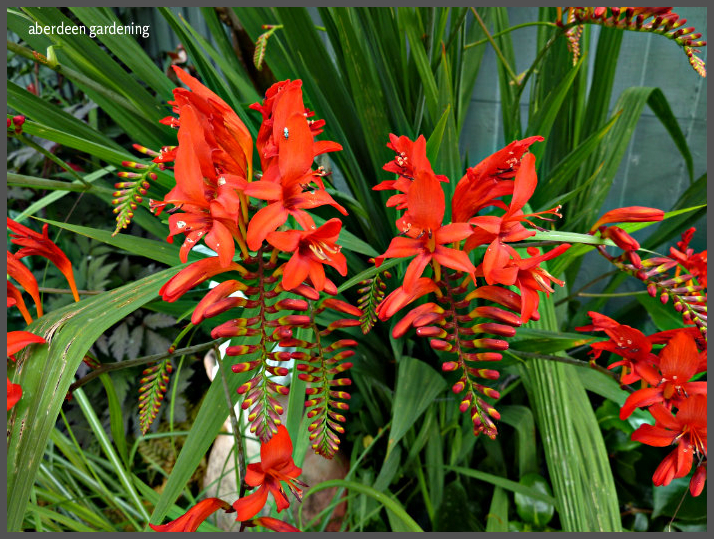
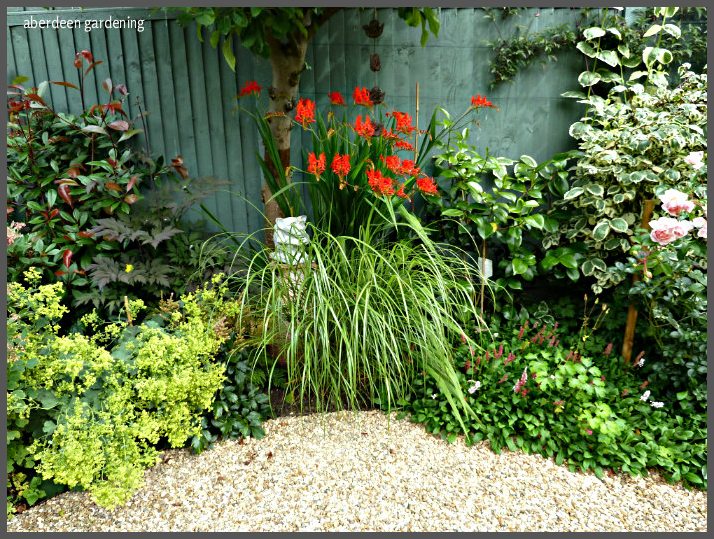
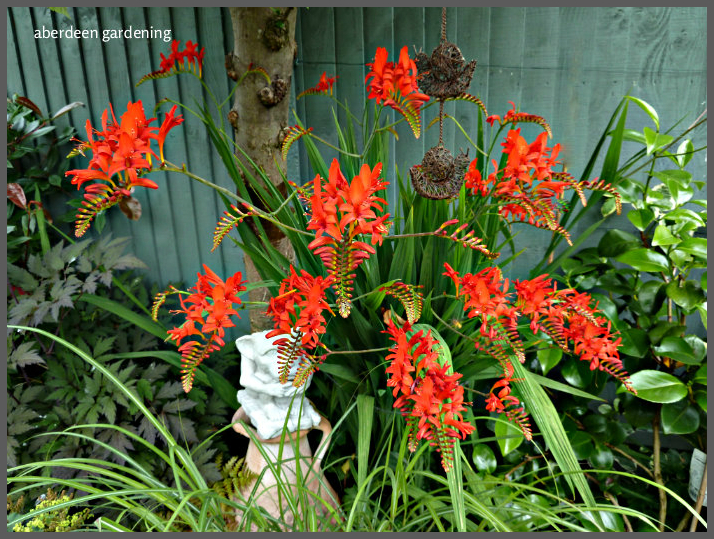
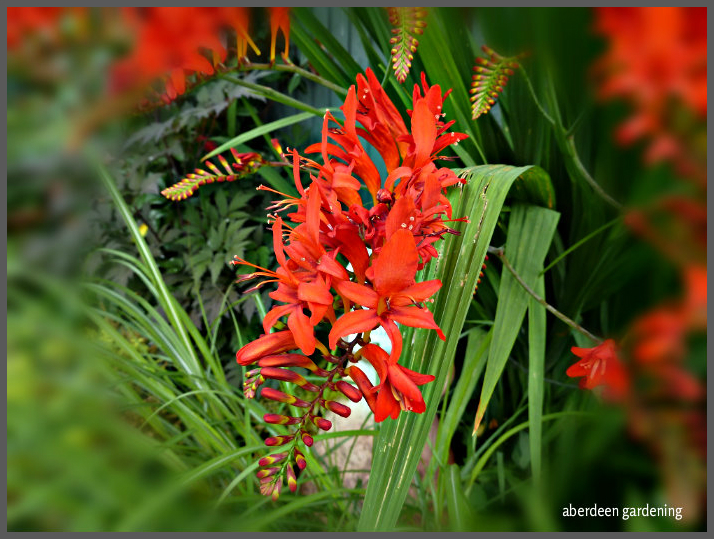
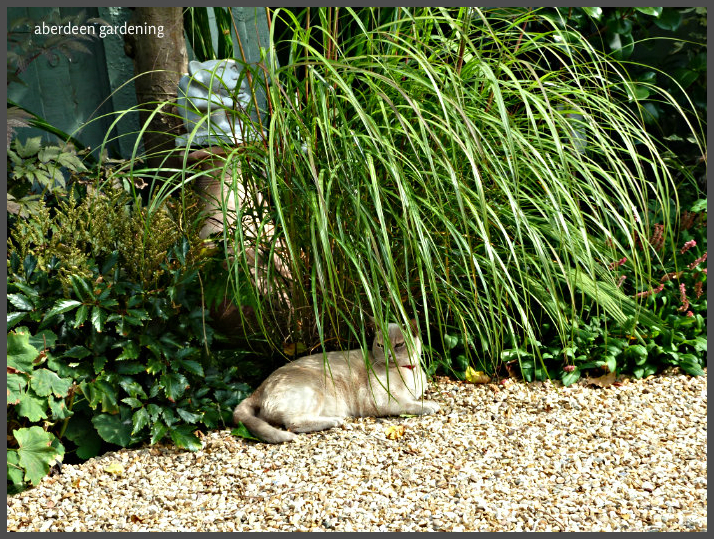
You certainly have to keep on top of those Crocosmia.
I have the ordinary orange one. Trying to gather them in two clumps, but they are everywhere!
John, I guess what I was doing was more or less equivalent to the skimming method you suggest. Mind you, as I say, I am now more than happy to keep the Crocosmia.
Anything that was originally planted by myself and spreads gets the thumbs up…..its a freebie. We have Crocosmia in a number of reds, yellow and the traditional orange, they all light up the garden with one species still flowering as of October. I would have thought that an easier way to stop them getting out of hand would have been to skim a circle around them under the soil, thus removing most of them. If the problem persists then treat it as in weeding. I removed a reasonable sized Pampas grass this year, I lagged the base of the hole with numerous layers of newspaper and filled the soil back in. The area was cleared to make way for a number of dwarf Hydrangea,Azalea etc, as of yet not a sign of anything coming back.
Sunil, I think your circus will be spectacular.
Hello Alistair, there’s an area where three borders meet that I will plant a whole mass of Crocosmia Lucifer in. I’ve called it “Crocosmia Circus” but at the moment, only one of the three borders is ready for planting so it’s going to be a bit one-sided, however, I’m hoping for a stunning effect when it’s all planted up and you’re stood right in the centre of it! Crocosmia is a favourite of the other half so it will be making a statement-feature in the garden.
Rick, a plant which grows well where little else thrives is a bonus.
‘Lucifer’ certainly works well for you there Alistair, I only introduced it a couple of years ago and immediately moved it and still have shoots coming up in the original position. I have the original montbretia (Crocosmia x crocosmiiflora) in the garden which at one time was ubiquitous but this has to have been introduced from seed and I am quite happy to accommodate it as in the way of things it has reintroduced itself into the rather more hostile areas of the garden which for one I am grateful and two controls its spread.
Donna, glad I was unsuccessful in my attempts to eradicate.
Lucifer, Yes Sue, perhaps a bit of divine intervention is necessary at times.
Dear Helene and Alistair, I’ve followed both of you move, and Diana too, and can see it is very hard, or maybe mixed because it’s also exciting to be moving. I’m aware one day I’ll be in that position too. I haven’t used crocosmia, but I’ve experienced a few others that move in and simply refuse to leave. In this case, what can you expect with a name like Lucifer?!
I actually have this very flower and I love seeing it…..it will remain where I planted it, good or bad…and the hummingbirds are as happy as I am to see its amazing show in summer. I have lost many a battle in my garden.
Helene, perhaps starting over again with the crocosmia would be wise, they were looking so good in your last garden before the problem started.
Yes I do get a lump in my throat when looking back at our last garden. I wish I could say I have no regrets. Perhaps it was too late in our life to be doing this, the worst thing is, that sense of not belonging. Never mind, at least its a bit milder here. If I do find what may be the problem with the crocosmia, I will get in touch. Alistair
That would have been great, as I am always curious to know what’s going on in my garden, but I cut down the leaves 2 weeks ago of the crocosmias I took with me as they looked so awful and they were finished flowering a long time ago anyway. Lucifer flowers mid-July for me, has always done and lasts for about 3 weeks and then it’s all over. I have been trying to find a photo of what the problem looks like, but I have been too good at pointing my camera away from areas with issues, and cropping hard when needing too – only want to show the good bits like we all do you know! So unfortunately I don’t have any photos, and no leaves left, and I will just throw away what I got here. Since they ended up the same after being dug up and planted in fresh compost I have decided to start from scratch with new corms. Time will tell if it’s me or the corms!
Here is a link to what my clump of Lucifers looked like in my old garden:
http://graphicality-uk.blogspot.co.uk/2013/07/hot-colours-for-hot-july.html
I do miss the garden when I look at pictures like this, do you too when you look at photos from your old garden? I don’t regret moving house, but it was a big thing leaving the garden – even if I took a lot of plants with me 🙂
Thanks Angie, I will look out for George Davidson, I wont forget the name as it is also the name of a blue pulmonaria which I am fond of.
Janet, I have had experience with the common montbretia and yes it can be a problem in the mixed border.
I adore ‘Lucifer’, but as with all crocosmia, I think you have to be reasonably sure that you want it where you plant it because it is the very devil to get rid of! Persistence seems to be paying off in my front garden, where three years on I no longer have enough of the wild montbretia to produce a single flower, but I think that’s because the soil is so sandy that it is fairly easy to get rid of the corms as soon as the leaves betray their location. I’m glad your ‘Lucifer’ has proved to be garden worthy after all, it looks excellent behind the miscanthus.
I inherited massive clumps of Crocosmia when I took over this garden and I resorted to digging out massive clumps, each clump of corms/bulbs filled one of those huge Ikea bags and I was left with huge craters in the side garden. It was extremely hard work at the time but worth it as they never reappeared.
I do have C. Lucifer and know from reading about it since I started blogging that I will need to keep on top of it.
If you are looking for a nice yellow one – I can recommend C. George Davidson Alistair. It does well in my garden here so should be good for you down there in Chesire.
Lucifer, last to show, perhaps he is building up strength for next year.
Yes Cathy, Purdee is looking content in her retirement.
Helene, we will have to do some checks to see if we can find out what is causing this problem with your Crocosmia.
It’s funny you are writing about Crocosmia ‘Lucifer’, I had them in my old garden for more than 10 years and I absolutely loved them – in the beginning. I didn’t find their invasive trait a problem, I dug them up a few times and divided and gave away lots and threw away some. My problem in recent years was that the leaves got attacked by a disease every year, usually before the flowers even had emerged, and by the time the flowers started to open, the leaves looked like they were ready to be cut down. I am not sure what was wrong, it looked a bit like red spider mites, but I could never see any – and I could see the mites when I had them on other plants. It could also look a bit like some kind of rust. I dug up all the corms, potted about 30 and threw away the rest when moving over here, but sadly the leaves look exactly as awful as last year and the years before. I am going to throw them out and start all over with fresh, new corms as I really love them, possibly with a shorter variety – I have seen a really nice, dark red one, can’t remember the name but I will definitely have crocosmias in my new garden.
The mean treatment of your crocosmia seems to have spurred it onto just keep on throwing out new growth, it looks really nice and I bet it will look just as nice next year too 🙂
Alistair, whatever the reason, it certainly outperformed for you! But I especially loved the picture of Purdee!
Oh that’s quite funny! And a very spectacular (though rather devilish) Lucifer! I love Crocosmia and just planted corms for Lucifer and two other varieties this Spring. I have yet to see anything of Lucifer, though he may be hiding somewhere in the flower bed, but one of the yellow/orange ones is just starting to bloom. So beautiful!
Annette, The common orange montbretia is more of a thug than Lucifer and yes it can easily get out of control. I think if I were to use a similar tactic next year on Lucifer it may well result in weakening it, or would it.
Hi Alistair. I can confirm the Crocosmia certainly thrives in Aberdeen. We have the red Lucifer and an orange one, very similar, but slightly later. However, I can also confirm that once you plant it you will never be rid of it and certainly recommend that you do indeed dig it up every two to three years or you will have an impossible task. We rather foolishly left a whole border of ours for at least 15 years until it stopped flowering. The corm chains grow downwards, sidewards or anywhere they can find a space and as you say if they get amongst roots they just cannot be removed. That said, they are a wonderful plant and I am glad you are allowing yours to stay. It looks smashing behind your Miscanthus. I hope it flowers as well for you in the future – we won’t tell it that it doesn’t need to be on its best behaviour any more.